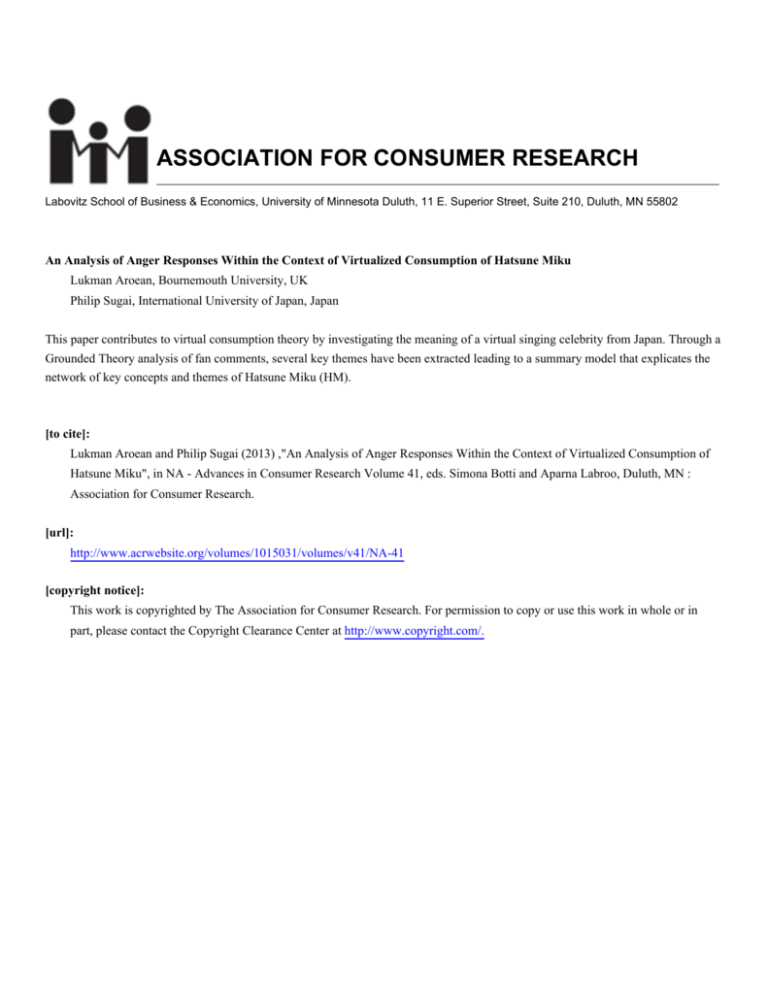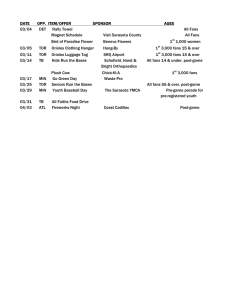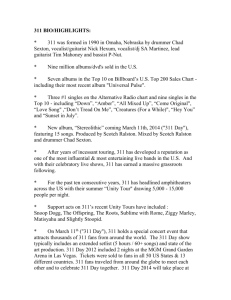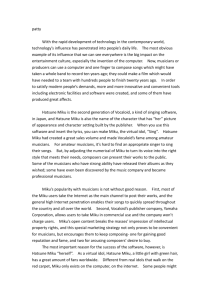An Analysis of Anger Responses within the Context of Virtualized
advertisement

ASSOCIATION FOR CONSUMER RESEARCH Labovitz School of Business & Economics, University of Minnesota Duluth, 11 E. Superior Street, Suite 210, Duluth, MN 55802 An Analysis of Anger Responses Within the Context of Virtualized Consumption of Hatsune Miku Lukman Aroean, Bournemouth University, UK Philip Sugai, International University of Japan, Japan This paper contributes to virtual consumption theory by investigating the meaning of a virtual singing celebrity from Japan. Through a Grounded Theory analysis of fan comments, several key themes have been extracted leading to a summary model that explicates the network of key concepts and themes of Hatsune Miku (HM). [to cite]: Lukman Aroean and Philip Sugai (2013) ,"An Analysis of Anger Responses Within the Context of Virtualized Consumption of Hatsune Miku", in NA - Advances in Consumer Research Volume 41, eds. Simona Botti and Aparna Labroo, Duluth, MN : Association for Consumer Research. [url]: http://www.acrwebsite.org/volumes/1015031/volumes/v41/NA-41 [copyright notice]: This work is copyrighted by The Association for Consumer Research. For permission to copy or use this work in whole or in part, please contact the Copyright Clearance Center at http://www.copyright.com/. An Analysis of Anger Responses within the Context of Virtualized Consumption of Hatsune Miku Lukman Aroean, Bournemouth University, UK Philip Sugai, International University of Japan, Japan ABSTRACT Does anger reflect deep meaning of attachment and integration? In an effort to explicate the above notion and to capture the rapidly evolving consumer behaviour in the digital virtual terrain, the paper investigates the responses of fans to a break-out phenomenal from Japan, the virtual celebrity Hatsune Miku (HM) to a controversial report from CBS news (see Johnson, 2012). The meteoric rise to fame of HM, a Crypton Media-produced Vocaloid character which resembles a 16-year girl, is demonstrated by the sales of total HM brand goods reaching 10 billion yen (approximately $104 million USD), and by more than 350,000 vocaloid videos on YouTube and 92,600 such videos on Niconico douga - a Japanese YouTube-like site (Wikia, 2012; Santos 2011). On one side, the responses from fans to inaccurate claims by CBS news are replete with furious, cynical, and sarcastic comments that not only defend the credibility of HM, but also brutally criticize the validity of the proposed “fake-ness” of HM. Such comments even go beyond attacking the author of the article, and retaliate with attacks on America as a nation in response to a perceived attack on Japan within the article itself. On the other side, the responses unveil the deep adoration and love of fans to HM and the meaning, the aestheticism, and the values that HM gives to these fans and co-creators globally. With the ignited deep anger from HM fans due to the CBS report opening an unprecedented view of the “inner thoughts” of HM from “her” fans, this paper contributes to the domains of virtualized consumption and consumer emotion by exploring HM fans’ responses, extracting a number of key concepts and themes, and examining the link between them, including her real-ness and desired experiential rewards that the fans claim to truly enjoy. THEORETICAL BACKGROUND Virtualized consumption Enjoying HM can be seen as a form of virtualised consumption (see Denegri-Knott & Molesworth, 2010) that signifies the experiential pleasures it brings to consumers neither from materialised consumption nor a tangible encounter. Such virtualized consumer experiences with objects that hold limited material existence challenge classical theories of consumption based on rational or utilitarian needs (Firat and Dholakia 1998). Similarly Kline, Dyer-Witheford & de Peuter (2003) proposed that virtualised consumption represent the latest stage in an ongoing, subtle transformation of consumption practices from utilitarian emphasis to one of pursuing aesthetic, emotional, symbolic and experiential value. As such, as consumer culture increasingly moves away from the material, the experiential orientation places individual consumers as the main creative power who in turn reconfigures the process, output and the types of consumption practices. Hence, virtualised consumption can be seen as rooted in experiential consumption theory that signifies feeling, fun and fantasy as essential elements of experiential consumption making it distinct from utilitarian consumption (Holbrook and Hirschman 1982). Similarly related work (e.g. Baudrillard, 1970, Campbell, 1987, Featherstone, 1992; Lee, 1993) conceptualize consumption as a symbolic, aesthetic, imaginary experience. Adopting three characteristics from the literature, this paper conceptualizes the virtualized consumption as a consumption characterized by a hybridized experience, stimulatory-actualizing-ex- perimenting nature, and co-creative harmony between provider and consumer. Hybridized Experience Digital virtualised consumption can be seen as a hybridization of the material and the virtual that allows individual consumer to enjoy the hybridized experience that Burbules (2004, 163) refers to as “both material and imaginary,” or what Shields (2000, 2003) terms as “liminal,” meaning “in between”. This hybridization process operates when there is a complementing state between the actualizing potential of the material with the idealizations of the virtual (Shields 2000, 2003; Burbules 2004). The rich and salient experiential opportunities and stimuli available in the digital virtual product obviously attract individuals to buy, try and explore a whole new array of exotic “ideal” functionalities (digital capacities) based on their desired abstract ideas. Putting this into the context of HM, while the stimuli and features from the digital software (e.g. HM vocalizing synthesizer) provides the contextual hybridized experiential environment, conceptually enjoyable virtual consumption possesses essential processing characteristics as explained in the following section. Stimulatory – experimenting – actualizing essence The hybridized state of this virtualized consumption experience conceptually operates when there is stimulating–experimenting–actualizing process within the experience (e.g. Denegri-Knott & Molesworth, 2010), and this determines how an individual consumer encounters and enjoys virtual rewards. Enjoyable virtualized consumption is simultaneously (1) Stimulating – activating their creative virtual capabilities; (2) Experimenting – prompting consumers in such a liquidity to explore, speculate, and combine different available features; and (3) Actualizing – enabling consumers to bring their dreams into the ideal end result. In the case of HM, the hybridized state of virtualized consumption, indicates harmony between marketers (the providers) and the market (consumers) that enable consumers individually and in connection with like-minded consumers to co-create, co-develop and share the final experiential products innovatively and harmoniously (see also Bauman 1988; Lee 1993). Additionally, the emergence of HM highlights how the market now provides not only the source material for the imaginary consumption and the activities for enjoying it (e.g. the music production and the performance), but also the creative power that enable consumers to generate their desired aesthetic experiential experience different from other creators. Conceptually the three processing aspects of hybridized-virtualized experience might be related to the complex, inductive inference processes of anthropomorphism: acquisition-activation-application, and the corresponding determinants: Sociality-Effectance-Elicited agent knowledge (Epley, Waytz & Cacioppo, 2007). The hybridized-virtual experience of HM does take place in the agentic, anthropomorphic environment that leads to complex, rich and salient essence of its socio-psychological aspects. Virtualized consumption process and consumer emotion The creative, fantasy-laden process of developing such virtual experiences provides rich and salient space for in-depth involvement of the emotions of the engaged individuals (e.g. Holbrook and Hirschman 1982). Not only do such emotions colorize the personal 342 Advances in Consumer Research Volume 41, ©2013 Advances in Consumer Research (Volume 41) / 343 process of virtual production, but the emotional connection built through this process become deeper and more intense because the individuals who co-create virtual characters become personally connected to their creations and profoundly treasure these characters as if they were their own flesh and blood. This connection between virtual consumption and the emotions that arise from this process is fundamental for the contribution of this paper. METHOD The authors analyzed all 159 comments posted on the CBSNews website in the 12 months between Johnson’s April 2012 “World’s Fakest” article was published and March, 2013. In order to better understand the comments that were posted, we also observed other corresponding online sources, such as youtube, facebook, niconico douga, and mikubook.com which in combination provided us with rich consumer data and information to enable our analysis of their views, opinions, feelings, emotions, thoughts, ideas and expectations. In this regard, our paper employed an exploratory analytical approach that combined related perspectives not only from consumers’ point of view. Despite the fact that demographic details were not provided in a straightforward manner, some of them could be identified within the contents of their comments. More importantly, the freedom that individuals had in expressing their personal views provided valuable insights into the nature, meaning and symbolic values of HM, that would have been extremely difficult to collect in a more structured environment. We chose to employ a Grounded Theory (Strauss & Corbin, 1994; Glaser & Strauss, 1967) approach to this research study because Grounded Theory requires focused data collection and analysis prior to theory development. Because this is the first academic study of Hatsune Miku or other Vocaloid characters, such a grounded approach was deemed appropriate. By approaching the data in this way, we were able to examine the responses and focus on the profound emotions, thoughts and aspirations by repeatedly reviewing the entirety of individual responses, their wordings, capital letters and punctuations used. After inputting all HM’s fan comments into a qualitative data analysis software package, we then scanned the whole data for coding and search key themes and concepts. We used these to organize and code all comments to arrive at a structured list of core constructs outlined below and generate a summary map. As a large number of respondents are Japanese, unsurprisingly their responses contained some Japanese words, which also helped us to approach the meaning of HM to fans. ANALYSIS AND FINDINGS With more than 172 mentions within the entire set of responses, the word “fake” (and fakest) was a powerful influence to ignite the anger of HM fans. This key word – fake – are so important that we use them as the pivotal starting point to identify and classify the strengths and types of anger from HM fans and link these to their unveiled insights of HM. We analyzed and interpreted the relative strength of anger levels by examining the intensity of emotions exposed in the responses and classified these into strong and moderate intensity categories. We also analyzed the types of anger expressed into positive and negative categories based on the concepts expressed by individual fans. We re-categorized the contents of responses into two broad anger meta-constructs of “the positivity”: the meaning, the aestheticism, and the values that HM gives to these fans; and “the negativity”: criticisms and accusations towards the report, the journalist and America at large. In doing all these, we also attempted to explore and identity anthropomorphic representation and meaning, including simple metaphoric statement but with strong intense. At the end, from our interpretive process, a clear framework emerged to identify and link the two core meta-constructs: (1) anger, and (2) love/adoration. Positive Anger Within the positivity anger meta-construct, three major constructs were identified followed by eight linked concepts. Positivity anger construct 1: “Real”-ness The positive construct of real-ness comes at strong anger intensity. When the CBS journalist argued that HM is fake, or in fact the “fake-est” star (Johnson, 2012), the majority of fans responded strongly that they did not only disagree but strongly felt that labelling HM as fake was completely misleading. “She’s a real singer for me!! and she is IMMORTAL!” (Mikuosan) “… it is a real voice, a real talent and a REAL PERSON” (MRWALRUS) Within this construct, it was also suggested that that HM’s real-ness was connected to Japan’s cultural and religious heritage: ‘souled idolation ontology’ – in which everything has a soul. ... I’m a native Japanese in Japan. To come to the point, you are totally ignorant on Japanese culture and thinking. We have a special affection for human-shaped objects under the influence of Shinto culture. In Shinto everything and anything in the universe, both animate and inanimate, even the artificial material, has its own “soul” or “spirit” in it….This can be one of the reasons why Japanese people love virtual idols. I hope my poor explanation would be an access to better insight on Japanese culture (Damesuke, Japan) Both Johnson’s CBS article and the fan responses confirm that HM is more than a computer program or hologram, and is in fact a powerful “star” and idol. Her fans lovingly call her “Uta Hime” which can be literally translated into English as “Princess of Song”. Praising HM as Princess of Song goes beyond ordinary pop star status. “Whatever, guys. Ya’ll don’t know nothin. She’s utahime and that’s that.” (FX9095) “Miku is not a pop star she is a utahime” (YONOP) Positive anger construct 2: “human” celebrities are “more” fake This positive anger construct emerged at moderate anger intensity demonstrated by a more moderate emotional tone. This construct exhibits a disagreement with labelling HM as fake and rebuts that there are so many “real” celebrities who behaves fake or pretend to be someone else. These respondents further argue that HM has nothing deceptive – she is genuine. HM has tapped into a deep and resonant chord with her creators and fans that unveils the latent desire to exhibit no pretence – no deception life. The adorable genuine kind of life “she” has garnered is evident in many fan comments and is energizing. “The world is filled with fake celebrities, pretending to be something they are not, remade by image consultants, keeping up appearances with a polished veneer. Hatsune Miku is none of these things. She is exactly what she appears to be, with no pretence or deception. She is the sum total of the hopes and 344 / An Analysis of Anger Responses within the Context of Virtualized Consumption of Hatsune Miku dreams and creative energy of her legions of adoring fans, and can be nothing else. She is quite possibly the most genuine celebrity to ever grace the earth.”(Erik_Romero) Positive anger construct 3: Acceptance to the “un-realness” being of HM The un-real-ness construct emerged at a moderate intensity level of anger. This construct also highlights the creative and innovative nature of HM, as many fans defended HM in terms of the creativity and innovativeness that this Vocaloid technology and database enable. HM is seen as one of the superb achievements of Japan. HM is obviously about music and the enablement of musical expression, giving artists the ability to put a “voice” to their music without the need for a physical singer. “Everybody who loves miku and other Vocaloids already know they are not real people but also know that they’re part of a real program, a real instrument that an artist can use to create a fabulous new things.” (SUZUMIYA_KAI) In addition to the creative-innovative side of HM, one extra construct of special note emerged related to the attention placed upon the co-creative business model that is at the heart of HM. The holographic image of HM has performed multiple sold-out concerts in her home country and in many countries around the world. Projected on a screen and supported by a live band, Miku sings and dances according to the direction of programmers who “designed” the concert in advance. “The point is that Hatsune Miku isn’t actually a pop star at all if you want to analyze her, she is the product of her fans, literally. Her songs are made by individual artists, her appearance is as fans illustrate her. The only thing which belongs to her is her voice, and that is by Saki Fujita … She is much greater than a person. We call her an idol or a goddess specifically because she is less an individual than an collective abstraction. She is Hatsune Miku, and nothing else (Kakisho)” The un-real-ness construct also pointed to real productions that HM participates in, but is unharmed by this participation. HM was celebrated for her innocent life both within Johnson’s CBS article, and within the fan responses to it. “So she’s not real as we know it, because she’s a program. However It’s a really neat thing to go see if you’ve ever seen one of their shows. She also endorses products just like any other celebrity. The only thing she can’t do is go out and ruin her life, or get hooked on drugs, and end up in rehab. (Dish12) Negative Anger Within the “negativity” anger meta-construct, all with strong anger intensity, three constructs were identified. Negativity anger construct 1: Offensive A majority of the fan comments included at least some shade of anger or frustration in their response. The passion within such responses can be best shown in the following two comments: “I was literally flipping tables when I read this, I’m a die-hard vocaloid fan, and I thought only Fox news was bullsh*t.” (ANI-MAN) “THINK BEFORE YOU ******* WRITE A ARTICLE!! I’ve already gotten some Miku haters on my youtube channel because of this.” (Hatsunemikufan_101) Negative anger construct 2: Mocking Because many of the proposed “facts” within the article were in fact not true (i.e. HM “is a hologram….more accurately she is a digital avatar.”), and the author openly stated that she used Wikipedia as her main source of research, many fan responses mocked the author and CBS in terms of their credibility. “CBS needs to do some research. Yeah I wouldn’t called looking on Wikipedia ‘research’ for a multi billion dollar company.” (LUCCHINI2) “If CBS wants to bash on Miku and the Vocaloids, then by all means, you might as well glorify Jersey Shore and encourage teenagers to quit school to get drugged up and pregnant. I commend you, CBS.” (XYINXYANGXYOUKAIX) Negative anger construct 3: America-bashing As the content of Johnson’s original article positioned HM as different, strange and something purely Japanese, many responses took offense to this and turned to anti-American sentiment in return: “How wonderful is it that other countries in the world actually have the ability to create something wonderful and 10th Generation for entertainment compared to your drug Fu***ed society.” (IGNORANT_JOURNALISTS_SUCK) Non-Fans’ positivity construct: Sympathy – Solidarity We also found non-fans’ comments and repeatedly throughout the commentary by HM fans, the concept of a larger group or community, in its most positive, collaborative sense was mentioned and often celebrated. “I may not be a hardcore fan of Miku like my other friends, but even then I feel like this article just shoved at me a bunch of narrow-minded critiques said with no thought at all. I can’t even imagine the anger this article has caused to Miku’s fans.”(NinjaAutobot101) “Even if the person does so or not, it doesn’t change that you have offended millions of people over the world.” (Sakura772) As a summary, figure 1 entails all identified construct into one conceptual map. Figure 1: Conceptual Map of HM Note: Utahime means Princess of Song Advances in Consumer Research (Volume 41) / 345 SUMMARY OF KEY FINDINGS Our analysis brings to several key categorical findings. First HM is “real” because it represents the collective creativity of artists, illustrators, business entities and fans. Second, the co-production nature enhances on how strongly HM truly comes alive inside her fans. Third, the creative capability enables those individuals without music composition capabilities to join this new consumption culture. Fourth, HM is simultaneously stimulating, actualizing, experimenting and collaborating. HM is stimulating because it gives the desired freedom for consumers using resources and experiences so that they can obtain an (representative) ability to sing. In terms of actualizing, consumers actualize their latent desire in the form of songs they like others to listen and not yet expressed in any other manner. Lyrics, types of music and dancing style performance are the productions where consumers may enact their dreams of musicality and singing realms. Consumers actualize ideally possible imaginings or fantasies, like being a great composer or a choreographer that possess the ability to compose a fantastic song and to create a singing performance. Regarding experimenting, consumers enjoy experimentally exploring and combining different features available, including adopting different kinds of music, lyrics and voices, even possible for unable music individuals. All these give consumers some sort of status in HM society. These also give consumers space for expressing their esteem (personal values) like being a serious musician and choreographer. Fifth, exploring the anthropomorphic essence and perspective, there emerges from the fans the supreme perception of HM as Uta Hime (Princess of Song) without fail, supreme representation of HM as the symbol of innovation confirming Japan dominating US, and supreme protoplasmic, integrated consciousness between HM fans and HM as their created darling. The first and the latter definitely contain much emotive elements, especially love and adoration. More specifically, the personification (or humanization) of HM into her fans reflects the harmonized dispositional, situational, developmental and cultural integration of HM as the fans’ anthropomorphic agent, cognitively – ability of the fans to express and perform the elicited HM knowledge - and motivationally – strongly motivated to explain the complex stimuli of HM effectively (termed as effectance, Epley et al 2007) and strongly motivated to socially defend HM and her fandom community with respect to her realness authenticity and contribution (termed as sociality, Epley et al 2007). IMPLICATIONS AND FUTURE RESEARCH The findings imply that virtual consumption enables profound emotional connection between co-creating consumers and their virtual character, perhaps due to the co-creation nature of HM that individual consumer may take significant role in final production of HM. Taking further the discussions above, with the summary map implying anger related to love and adoration when the anger has positive perspectives and arguments defendable to criticism, there remains interesting gaps. First, from anthropomorphic domain, does the success of HM as a powerful (even spiritual) agent of individual existence and social connection reflect a lack of human connection in the society? Also, in the future, research examining more sociocultural values within the virtual co-creating consumption like HM can be worthwhile, for instance to comprehend the souled idolation ontology or the desirable no-pretence life principle. REFERENCES Baudrillard, J. (1970), The Consumer Society, Myths & Structures, UK: London BizRate.com (2000) BizRate Press Release, 23 October 2000, [Path: http://bizrate.com/content/press/release. xpml?rel=88.] (accessed 14 Dec 2012) Bauman, Z. (1988), Freedom, Milton Keynes, UK: Open University Press. Burbules, N. (2004), Rethinking the virtual, E-Learning, vol. 1(2): 162–83. Caillois, R. (1958), Les jeux et les homes, Paris: Gallimard. Campbell, C. (1987), The Romantic Ethic and the Spirit of Modern Consumerism, London: Blackwell-IDEAS. Denegri-Knott, J. and Molesworth, M. (2010), Concepts and practices of digital virtual consumption, Consumption Markets & Culture, 13(2), 109-132 Epley, N., Waytz, A. and Cacioppo, J. (2007), On seeing human: A three-factor theory of anthropomorphism, Psychological Review, 114(4), 864-886. Featherstone, M. (1992). Consumer Culture & Postmodernism, UK: Sage Publications. Firat, F.A., and Dholakia, N. (1998), Consuming People, from Political Economy to Theaters of Consumption, London: Routledge Glaser, B. G. and Strauss, A. L. (1967), The Discovery of Grounded Theory: Strategies for Qualitative Research, New Jersey: Aldine de Gruyter. Holbrook, M.B. and E.C Hirschman (1982), The Experiential Aspects of Consumption: Consumer Fantasies, Feelings and Fun, Journal of Consumer Research, 9, 132-40. Johnson, B. (2012), Hatsune Miku: The World’s Fakest Pop Star. CBS News, [Path: http://www.cbsnews.com/8301-205_16257547707/hatsune-miku-the-worlds-fakest-pop-star/] (accessed 4 November 2012) Kline, S. ,Dyer-Witheford, N. and de Peuter, G. (2003), Digital Play, The Interaction of Technology, Culture, and Marketing, Montreal: McGill-Queen’s University Press Lee. M.J. (1993), Consumer Culture Reborn, London: Routledge Santos, C. (2011), The World Is Hers: How Hatsune Miku Is Changing Everything, [Path: http://www.animenewsnetwork. co.uk/feature/2011-07-15] (accessed 4 November 2012) Shields, R. (2000), Performing Virtualities - Liminality On and Off the Net. [Path: http://virtualsociety.sbs.ox.ac.uk/text/events/ pvshields.htm] (accessed 14 Dec 2012) Shields, R. (2003), The Virtual, London: Routledge. Strauss, A. and Corbin, J. (1994). Grounded theory methodology. Handbook of qualitative research, 273-285. Wikia. (2012), Hatsune Miku, [Path: http://vocaloid.wikia.com/ wiki/Hatsune_Miku_(mascot)] (accessed 4 November 2012)







